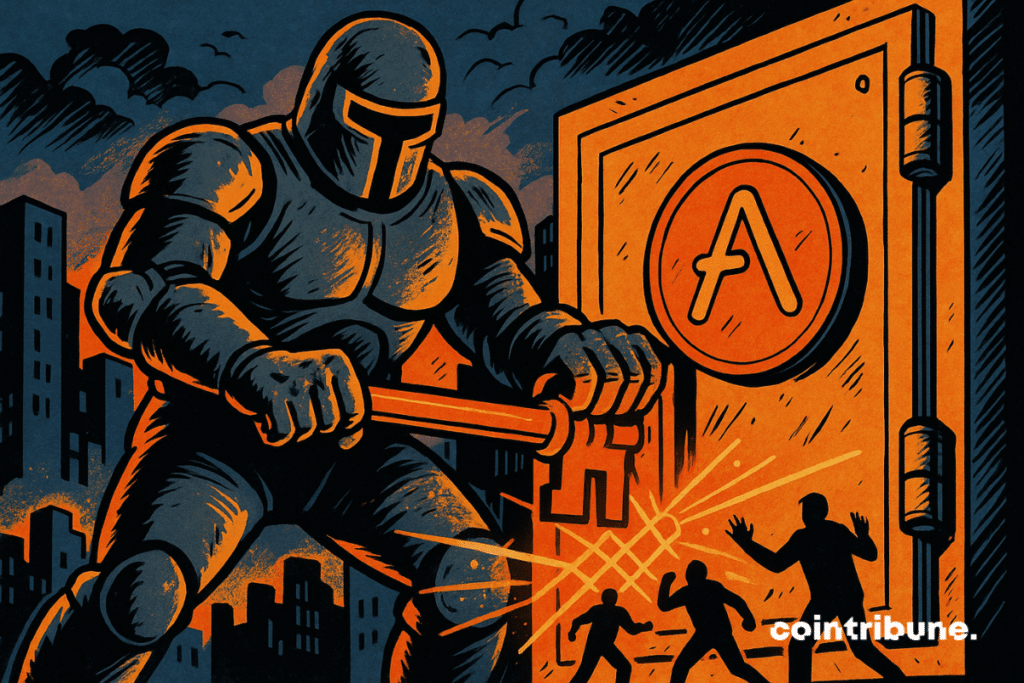Aave: The Symbol Of An Increasingly Centralized DeFi
Present since 2017 under the name EthLend, Aave reflects the transformation of DeFi. Indeed, five years after the DeFi Summer of 2020 during which decentralized finance emerged from its embryonic phase, this new economic sector has entered a new phase.

In brief
- Aave, launched in 2017, symbolizes the maturity of DeFi with strong leadership.
- After crises, DeFi is centralizing around secure and regulated projects.
- Ethereum and its layer 2 solutions dominate DeFi, concentrating the majority of capital.
Until 2023, we saw the emergence of a very large number of applications across an increasing amount of blockchains. But we are now far from that situation. Decentralized finance is now dominated by essential projects. And some of them, present from the origin of DeFi, now have partnerships with traditional finance.
Among them, Aave is therefore the clearest symbol of this success of the DeFi OGs with its undeniable position as a leader.
The paradoxical evolution of decentralized finance
In five years, DeFi has undergone a real transformation. The summer of 2020, called DeFi Summer, was the founding moment of this sector. Aave, Uniswap, MakerDAO, Dydx, and other projects offered liquidity mining or airdrops to reward their earliest users. This created a virtuous cycle. Communities formed and the TVL (Total Value Locked) gradually increased. This initial success attracted new projects and new blockchains wanting to build similar ecosystems.
The notion of decentralization then meant an absence of regulation and a widespread dispersion of this new finance.
This dispersion did not only have positive effects. Hacks, scams, and bankruptcies with the market crash starting in 2022 discouraged many investors and farmers. This led to favoring the most well-known applications, concerned with security and increasingly complying with financial regulations.
The rise of the Real World Assets (RWA) sector completed this evolution. Indeed, these investments cannot be made without a legal framework, and only a few projects (MakerDAO, Aave…) are capable of meeting these requirements.
Leadership of Aave
Announced in 2017 under the name EthLend before taking the name Aave in 2020, this lending application gradually established itself as the dominant DeFi project. Initially deployed on Ethereum, Aave has always emphasized security and has cautiously expanded to other networks. Aside from Avalanche, Aave now mainly remains on Ethereum and its layer 2 solutions.
However, true to its spirit of transparency (Aave meaning “ghost” in Finnish), Aave now offers its infrastructure to other projects in the form of instances. Ethena, which created a stablecoin linked to the dollar, developed its instance on Aave for investors. But it is especially Eric Trump’s project World Liberty Finance that reveals the true purpose of this feature. It will allow financial institutions to use this architecture to create lending markets for increasingly tokenized assets.
Aave thus surpassed its record by reaching 30 billion dollars of TVL and confirms month after month its leadership position in DeFi. The AAVE token benefits from this place by being, just after Uniswap’s UNI, the second largest DeFi protocol token by market capitalization. Long used within the protocol in staking to create a collateral reserve in exchange for token distribution, AAVE will change its economic model since stakers will receive a portion of the protocol’s revenues.
The Ethereum ecosystem, the home of DeFi
Despite the development of many other blockchains and uncertainties regarding the strength of the ETH cryptocurrency, Ethereum remains, either on layer 1 or on layer 2, the reference network for decentralized finance. Of the ten DeFi protocols with the highest TVL according to the website DeFiLama, eight come from the Ethereum ecosystem. Uniswap, Aave, MakerDAO, Compound, Curve are all Ethereum OGs, present almost from the beginning of decentralized finance. Among the most important applications, Lido, EigenLayer, Ether.Fi, and Ethena arrived later.
Ethereum concentrates more than 50% of the TVL on DeFi applications and more than 50% on stablecoins. Institutional investors remain attached to this blockchain which has more than proven its security. While Tron manages to compete with Ethereum by attracting 30% of stablecoins, Tron and Solana are far behind in terms of applications, each holding about 7% of the overall DeFi TVL.
In fact, it can be observed that even when moving away from Ethereum, the value involved in decentralized finance is massively concentrated on a few applications. Token Terminal has shown that the capital present in DeFi is mostly concentrated on 25 key applications, leaving little room for the dispersion dreams of the previous cycle.
Decentralized finance is gradually entering a maturity phase, and we can see in hindsight that the dreams of DeFi Summer are far away. With the leadership of Aave and other flagship applications on Ethereum and its layer 2 solutions, it is clear that the capital present in DeFi is, in fact, very centralized.
Maximize your Cointribune experience with our "Read to Earn" program! For every article you read, earn points and access exclusive rewards. Sign up now and start earning benefits.
Passionné par l’histoire du Web3, je m’efforce de rendre cette nouvelle ère numérique plus compréhensible grâce à mes articles et à ma thèse de doctorat en cours sur le sujet.
The views, thoughts, and opinions expressed in this article belong solely to the author, and should not be taken as investment advice. Do your own research before taking any investment decisions.